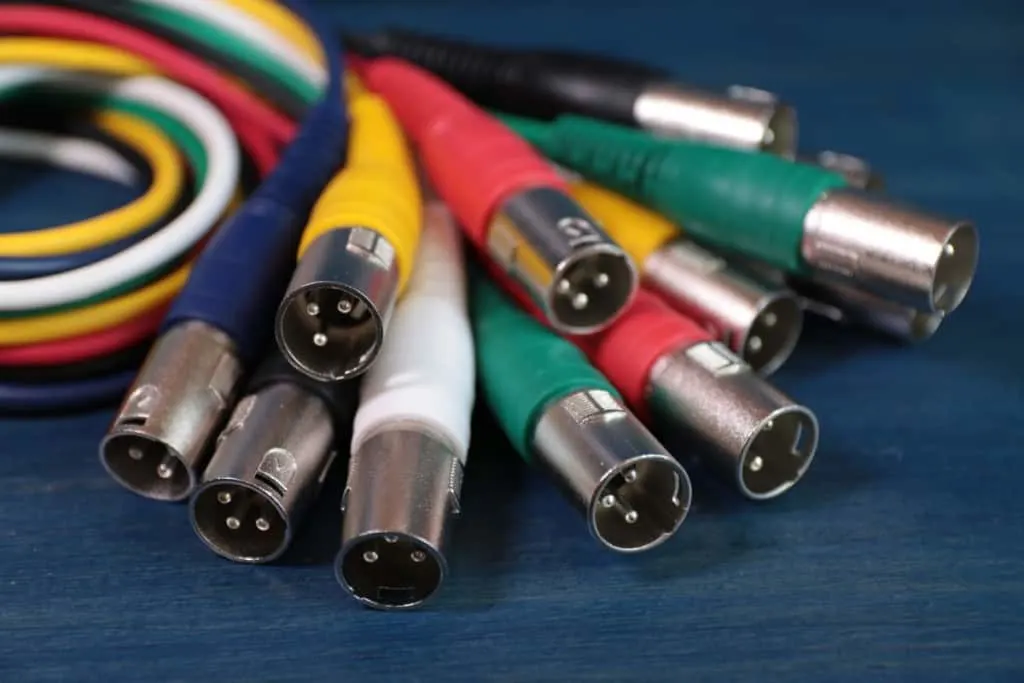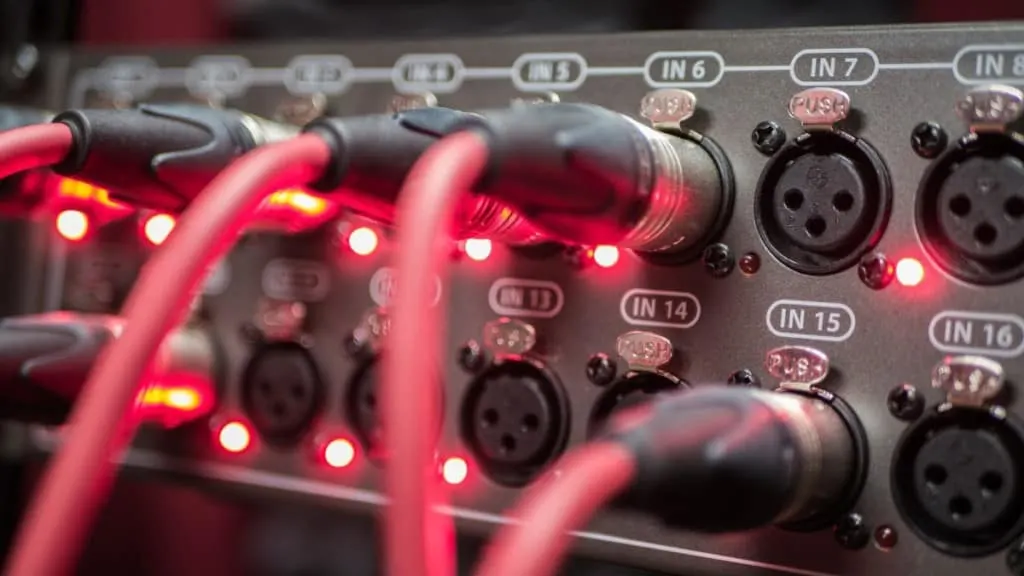I’ve worked with XLR cables all my professional life and have used all sizes you can think of. Let me pour all that wisdom into this blog post so you can benefit from my mistakes with XLR cables without you having to repeat them.
If your cables don’t produce a good sound then all your effort and investment are gone down the drain in a heartbeat.
So, how long can an XLR cable be?
XLR cables can be used up to 200 feet. When XLR cables reach 200 feet in length, you start noticing some noise and static that isn’t common in a balanced signal. As long as you can keep XLR cables shorter than 200 feet, you’ll be fine.
Do you want to know everything about this topic? I have loads to tell you so read on!
A Balanced Signal Goes A Long Way
Let’s explain the basic concept behind XLR and why they are sound professionals’ best allies ever.
When a signal goes into a common ¼” cable, like the one you’d use to plug a guitar, the signal travels through it picking up all the noises in the way and degrading after 15 feet. Why does this happen?
This happens because a regular guitar cable is an unbalanced signal.
XLR cables are different in their construction; they can balance the original unbalanced signal. Let me briefly explain to you why in some simple items:
- The XLR cable has three cables in its interior. Two of them have opposite polarities and the third pin is the ground.
- Once the cable picks the electrical current (AKA the sound), it inverts the phase among the positive and negative pins.
- The sound travels the entire length of the cable rejecting all the interference through the shielding.
- Whatever noise it picks up on the way despite the shielding is phased out when it reaches its destination, and polarity is inverted again.
Because of this construction method, the XLR cables are close to immune to noise. If you tried to go the same length with a regular ¼” cable, sound degradation would start at roughly 10 to 15 feet. Can you imagine what the resulting audio would be? Well, a little worse than that.

How Long Can An XLR Cable Be Before Audio Degradation Starts?
Although there is no specific measure given by science, most audio professionals, I included, notice it at around 200 feet.
That is close to 60 meters which is a lot for any sonic adventure. Picture it for a minute: what size must the venue be for you to run cables 60 meters from stage to mixing console? I was lucky enough to work on some major-act tours in which we had to set up the show at that level. You wouldn’t believe just how important cables are in the major leagues.
What Is A Cable Snake?
Speaking of long distances and huge stages, the best way to take XLR cables long distances is with a cable snake. Don’t worry, this isn’t a character from Cobra Kai, but an artifact that can solve many problems.
On one end of the cable snake, you have all the inserts where you plug in all the XLR-driven instruments on the stage. This end of the snake (can we call it the head?) is a big, usually black metal cube with female XLR connectors. This metal cube is where the body of the snake starts and it goes all the way to the other end where we find the male connectors that plug into the soundboard/mixing console.
Another interesting part about cable snakes is that the entire body is covered with either plastic or rubber and it is generally something you can step on.
For example, if you ever went to a stadium to see a band play, you might have noticed that the mixing console is facing the stage directly. You might also have noticed that rubber or plastic covers are going all the way from stage to the soundman. Under that plastic you’ll find the body of the snake going through, isolated twice.
The tail is usually a bunch of loose male XLR connectors ready to reinvert polarity and phase out all the noise they picked up being stomped on by a screaming crowd.
Why Do You Need A Cable Snake For Long Distances?
To begin with, long distances mean big venues.
Big venues often mean big crowds. Big crowds demand bigger sound systems and amplifying every single instrument. This, as a result, gives us a mess of 30-40 XLR cables to work with. Can you imagine trying to make out which is the cable that is not working when the full band is playing?
Well, cable snakes are labeled on the way in, and also on the way out and can gather all cables inside a safe, rubber “body” making that potential problem non-existent. Plus, being completely made of XLR cables, and with isolation running all the way, they offer crystal-clear sound from tip to tip.
Here’s a video of a wedding band cleaning up a white stage, using a cable snake; in case you’ve never seen one in action.
Take a look at cable snakes here on Amazon
Why Are Some XLR Cables More Expensive Than Others?
I would like to touch on a subject I’ve been hearing about for years but had to learn by myself. Why are some XLR cables more expensive than others? Why does cable construction even matter when it comes to XLR?
Well, in my years as a professional soundman I had to work with many bands and many different stages and budgets. The one thing that big acts invest in that smaller ones don’t is quality cables. The quality of the cables taking the signal from the stage to the sound person is just as important as the pickups on your guitar.
- Always remember the golden rule of sound: “a chain is only as strong as its weakest link.”
During those years I got to truly understand two important things:
- Cables make a lot of difference in the resulting sound. The bigger the band, the more instruments you have to mix, the more important cables are. Just multiply in your mind the hiss of 22 instruments coming out of the PA in a packed venue. It’s a deafening hiss; believe me.
- The above is true only if you have a decent PA. Sometimes we would roll off into beaten-up venues in the middle of nowhere and regardless of how good our cables were, the speaker enclosures would vibrate, the mixing console would make scratching noises, and so on. The quality of the system has to match that of the cables or you’ll be wasting your money on an investment that doesn’t make a difference.
Choosing Gear Can Be Really Hard!
Home recording requires a whole series of equipment, and it can be difficult to do the research to figure out exactly what to buy depending upon your budget.
I have written a complete guide to exactly which equipment you should get depending on your budget.
Here´s a video of PS audio CEO telling a story about the way changing cables made a lot of difference for a high-end audio system.
Anatomy Of A Good XLR Cable
Let’s say you have to run the sound for a show in a small venue and need some good cables for the musicians. What should you choose?
- Singers – Singers who don’t play an instrument need to have a cable that can take a lot of abuse but also that can isolate what is known as the “triboelectric effect”. This comes from those moments cables are stepped on or hit the stage strongly. You need a cable that has braided shielding and the best insulation in the market. Finally, try to get a cable with as high a strand count as you can, that way you’ll maximize durability and flexibility.
- Long distances – Let’s say you are putting together your cable snake, the cables you need for it need to have a short lay and a good conductivity material. The shorter the lay, the more noise cancellation you’ll have. Also, if the conductor is made with silver or gold, you’ll find an utterly conductive material that works wonders in sound quality.
- Get a star-quad cable – Finally, and this goes for all positions, you need to get into the quad revolution. What is a star-quad cable? Well, in simple words instead of using two opposite polarity cables, it runs four of them (two on each side). This reduces intermodulation distortion and overall noise up to 20 dB. You owe it to yourself to try one of these.

Conclusion
Chances are if you are a musician you already use XLR cables and have used them up to 20 feet.
If you are a professional musician, you might have used them up to 50 feet. Once you’ve crossed both those boundaries and play in the bigger leagues, you are going to see them running 200 feet for example. That is where most of us, working in the behind-the-scenes of the elite music business start noticing some sound degradation.
The scenario with ¼” cables is very different and that is why you should always use a direct box to transform to XLR to travel long distances. What are my favorites? I love high-quality Mogami cables; get them and you’ll be just fine.
I have written an article on DI Boxes, You can read it here.
Oh, and don’t forget to get a cable snake to clean up that stage!
Happy (noise-free) music-making!
